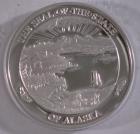1998 Alaska Medallion - The Moose


Current List Price $225.00
Like some of the other back issue Alaska medallions, the 1998 Moose has become difficult to find.
Total one ounce proof mintage: 10,200
Please CONTACT US for availability information.
Designed by Ira Levington of Anchorage, Alaska the 1998 Moose proof issued at $29.95. It is the only Alaska State Medallion to have a mintage number of over 10,000. Clicking on the above image will show this silver proof medallion has a very attractive clean design with the moose antlers standing out in the highly reflective background.
Moose are the world's largest members of the deer family. Moose are generally associated with the northern forests in North America, Europe and Russia. They're most abundant in recently burned areas that contain willow and birch shrubs, on timberline plateaus, or along major rivers.
Moose are long-legged and heavy-bodied with a drooping nose, a "bell" or dewlap under the chin, and a small tail. Their color ranges from golden brown to almost black, depending upon the season and the age of the animal.
Newborn calves weigh 28-35 pounds and within five months grow to over 300 pounds. Males in prime condition weight from 1,200 to 1,600 pounds. Adult females weigh 800 to 1,300 pounds. Only the bulls have antlers. Moose occasionally produce trophy-size antlers when they are 6 or 7 years old, with the largest antlers grown at approximately 10 to 12 years of age. In the wild, moose rarely live more than 16 years of age.
During fall and winter, moose consume large quantities of willow, birch, and aspen twigs. Spring is the time of grazing as well as browsing. Moose eat a variety of foods, particularly sedges, ezuisturn (horsetail), pondweeds, and grasses. During the summer, moose feed on vegetation in shallow ponds, forbs, and the leaves of birch, willow and aspen trees. Most moose make seasonal movements to calving, rutting, and wintering areas. They travel anywhere from only a few miles to as many as 60 miles during transitions.
Silver Trivia
In electronics silver use includes silk-screened circuit paths, membrane switches, electrically heated automobile windows, and conductive adhesives. Every time a homeowner turns on a microwave oven, dishwasher, clothes washer, or television set, the action activates a switch with silver contacts that completes the required electrical circuit.
The majority of the keyboards of desktop and laptop computers use silver membrane switches. These are found behind the buttons of control panels for cable television, telephones, microwave ovens, learning toys like touch and tell or speak and spell, and the keyboards of typewriters and computers. The low-current capacity of the membrane switch matches the low electrical current used for digital electronics. In an office environment, membrane switches are normally rated for a life of 20 million cycles. Typically, the membrane switch is made of a conductive ink of silver flakes in a polyester binder with carbon. This thick film is then silk-screened in an electrical circuit pattern onto each of two Mylar sheets. The two surface patterns of silver face each other close enough so that gentle touch by a finger will make the electrical contact. A latching transistor circuit is simultaneously activated to keep the circuit closed after the membrane is released.
Today's electrical appliances, such as microwave ovens, are controlled by membrane switch panels, where the contacts are silver. Membrane switch panels are found in automobiles and under the keys of personal computers. Due to their reliability and wide use, the silver-contact membrane switch market in the U.S. is a multi-million dollar industry.
